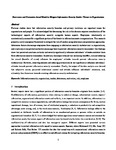Deterrence and Prevention-based Model to Mitigate Information Security Insider Threats in Organisations
| dc.contributor.author | Safa, N | en |
| dc.contributor.author | Maple, C | en |
| dc.contributor.author | Furnell, SM | en |
| dc.contributor.author | Azad, M | en |
| dc.contributor.author | Perera, C | en |
| dc.contributor.author | Dabbagh, M | en |
| dc.date.accessioned | 2019-03-29T11:50:01Z | |
| dc.date.issued | 2019-08 | en |
| dc.identifier.issn | 0167-739X | en |
| dc.identifier.uri | http://hdl.handle.net/10026.1/13581 | |
| dc.description.abstract |
Previous studies show that information security breaches and privacy violations are important issues for organisations and people. It is acknowledged that decreasing the risk in this domain requires consideration of the technological aspects of information security alongside human aspects. Employees intentionally or unintentionally account for a significant portion of the threats to information assets in organisations. This research presents a novel conceptual framework to mitigate the risk of insiders using deterrence and prevention approaches. Deterrence factors discourage employees from engaging in information security misbehaviour in organisations, and situational crime prevention factors encourage them to prevent information security misconduct. Our findings show that perceived sanctions certainty and severity significantly influence individuals’ attitudes and deter them from information security misconduct. In addition, the output revealed that increasing the effort, risk and reducing the reward (benefits of crime) influence the employees’ attitudes towards prevent information security misbehaviour. However, removing excuses and reducing provocations do not significantly influence individuals’ attitudes towards prevent information security misconduct. Finally, the output of the data analysis also showed that subjective norms, perceived behavioural control and attitude influence individuals’ intentions, and, ultimately, their behaviour towards avoiding information security misbehaviour. | en |
| dc.language.iso | en | en |
| dc.publisher | Elsevier | en |
| dc.title | Deterrence and Prevention-based Model to Mitigate Information Security Insider Threats in Organisations | en |
| dc.type | Journal Article | |
| plymouth.journal | Future Generation Computer Systems | en |
| dc.identifier.doi | 10.1016/j.future.2019.03.024 | en |
| plymouth.organisational-group | /Plymouth | |
| plymouth.organisational-group | /Plymouth/Faculty of Science and Engineering | |
| plymouth.organisational-group | /Plymouth/Users by role | |
| dcterms.dateAccepted | 2019-03-08 | en |
| dc.rights.embargodate | 2020-03-11 | en |
| dc.rights.embargoperiod | Not known | en |
| rioxxterms.versionofrecord | 10.1016/j.future.2019.03.024 | en |
| rioxxterms.licenseref.uri | http://www.rioxx.net/licenses/all-rights-reserved | en |
| rioxxterms.licenseref.startdate | 2019-08 | en |
| rioxxterms.type | Journal Article/Review | en |


